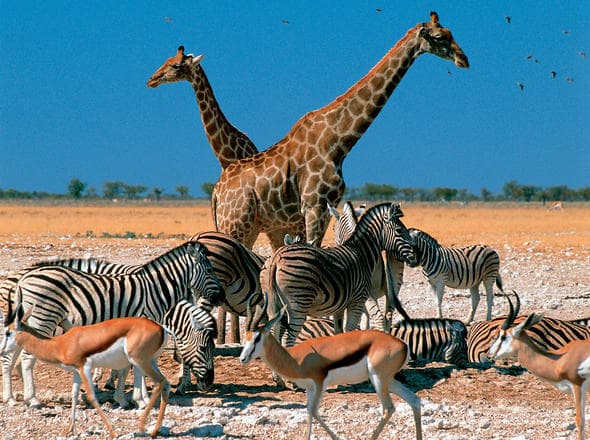
Namib-Naukluft National Park
Namib-Naukluft National Park features the world's oldest desert with iconic Sossusvlei sand dunes rising over 300m, offering spectacular desert scenery and unique geological formations.
national park
About Namib-Naukluft National Park
Namib-Naukluft National Park encompasses one of the world's oldest and most spectacular desert landscapes, featuring the iconic Sossusvlei sand dunes that rise over 300 meters (984 feet) above valley floors. Located in southwestern Namibia, the park combines the dramatic red and golden sand dunes of the Namib Desert with the rugged Naukluft Mountains, creating a landscape of extraordinary beauty and geological significance. The park is primarily visited for its stunning desert scenery rather than wildlife, though visitors may encounter desert-adapted species such as gemsbok, springbok, and occasionally brown hyenas. The landscape is characterized by constantly shifting sand dunes sculpted by wind over centuries, creating sharp ridges and perfect arcs that form an ever-changing natural artwork. The park includes notable features such as Deadvlei, famous for its stark white salt pan surrounded by towering dunes and dead acacia trees, and Sesriem Canyon, a narrow gorge with vertical cliffs and hidden pools. The Naukluft Mountains section offers a more lush environment with endemic Hartmann's mountain zebras and diverse smaller fauna. Visitors can explore the park through various activities including dune climbing, canyon hiking, and scenic drives along the dry Tsauchab River valley. The park's accessibility is enhanced by well-maintained roads and multiple entry points, with Sesriem serving as the main gateway settlement approximately 360 kilometers southwest of Windhoek.
Wildlife to See
Flora & Vegetation
Activities & Experiences
Landscape & Terrain
The park features the world's oldest desert with dramatic red and golden sand dunes rising over 300 meters, interspersed with gravel plains and the rugged Naukluft Mountains. The landscape includes the iconic Sossusvlei salt pan, Deadvlei with its dead acacia trees, Sesriem Canyon with vertical cliffs, and the dry Tsauchab River valley. The terrain is constantly reshaped by wind, creating sharp ridges and perfect arcs.
Conservation Efforts
Namib-Naukluft National Park is actively managed for conservation of its unique desert ecosystem and geological features. The park protects endemic species like Hartmann's mountain zebra and maintains the integrity of the ancient Namib Desert landscape. Conservation focuses on sustainable tourism management, wildlife protection, and preservation of the park's natural and geological heritage.
Local Communities
The park area has limited permanent settlements. Sesriem serves as the main gateway with basic services. The region is sparsely populated with nomadic and semi-nomadic communities historically present in surrounding areas. Local guides and tour operators provide employment and cultural exchange opportunities.
Photography Tips
Arrive at least one hour before sunrise for good light and to secure parking. Visit Deadvlei early morning or late afternoon for best lighting and shadows. Avoid midday when light is harsh and washed out. Use Elim Dune for sunset photography. Plan to reach furthest destinations (like 4WD car park) early to maximize photographic light on return journey. Bring protective gear for sand and dust.
Quick Information
Established
1907
Size
49,768 km²
Elevation
300 meters
Recommended Duration
3 days
Entry Fee
$80 USD
Average Cost/Day
$150 USD
Best Time to Visit
May to September offers the most comfortable conditions with cooler temperatures and less extreme heat. July to November is peak season with highest accommodation costs and crowds, though temperatures can become very hot from October. May and June provide excellent weather with fewer crowds and lower accommodation rates. December to April experiences oppressively hot temperatures that limit outdoor activities.
Getting There
From Windhoek: Drive southwest approximately 360km (220 miles) via B1 and C26 roads to Sesriem. From Swakopmund: Drive southeast approximately 345km (215 miles). The journey involves traveling long, lonely roads across often-empty landscape. Self-drive is popular; alternatively, join organized tours from major cities.
Nearest Airport: Windhoek International Airport (Hosea Kutako International Airport)
Nearest Town: Sesriem
Accommodation Options
Conservation Status
Protected national park with active conservation management
Start Planning Your Visit
Compare packages from verified operators and find the perfect safari experience

